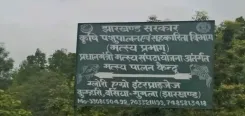Why Are Tourists Barred From Hogenakkal Waterfalls Due to Increased Flow?

Synopsis
Key Takeaways
- Heavy rainfall has led to increased water flow in Hogenakkal.
- The district administration has banned swimming for safety reasons.
- Authorities are releasing excess water from Karnataka dams.
- Public safety remains a top priority.
- Monitoring of the river continues at the Biligundlu gauging point.
Chennai, July 27 (NationPress) Due to heavy rainfall in the Cauvery catchment regions influenced by the southwest monsoon, there has been a significant increase in inflows into major Karnataka reservoirs—Kabini and Krishna Raja Sagar (KRS). These reservoirs have reached full capacity, causing excess water to flow into Tamil Nadu as well.
In light of this situation, authorities have activated the floodgates of both dams to ensure structural integrity, releasing large volumes of water into the Cauvery River.
Official reports indicate that 21,000 cubic feet per second (cusecs) of water is being discharged from the Kabini dam, along with 23,000 cusecs from the KRS dam, totaling a massive 44,000 cusecs entering the Cauvery.
This substantial discharge is now flowing into Tamil Nadu via the inter-state border point at Biligundlu, triggering a dramatic increase in water flow downstream at Hogenakkal in Dharmapuri district.
On Friday, the inflow at Hogenakkal measured 18,000 cusecs, which escalated over the next 24 hours. By Saturday evening, the flow had surged to 32,000 cusecs, and by Sunday morning, it further intensified to 57,000 cusecs.
This considerable rise in the river’s volume has caused the Hogenakkal Main Falls, Sinipalls, and Aintharvu streams to come alive, with water cascading dramatically over the rocks, attracting spectators from a distance.
However, prioritizing public safety, the district administration has prohibited tourists from swimming in the waterfalls for the second day in a row.
This restriction is in light of concerns that water levels may continue to rise as Karnataka persists in releasing excess water from its dams.
Officials from the Central Water Resources Department are vigilantly monitoring the river flow at Biligundlu, which serves as a crucial gauging point on the Tamil Nadu-Karnataka border.
With upstream inflows showing no signs of diminishing due to ongoing monsoon rains, authorities remain on high alert for potential flood-related emergencies in lower-lying regions. District officials have advised local residents and tourists to steer clear of the riverbanks and avoid entering any water bodies until conditions stabilize.








